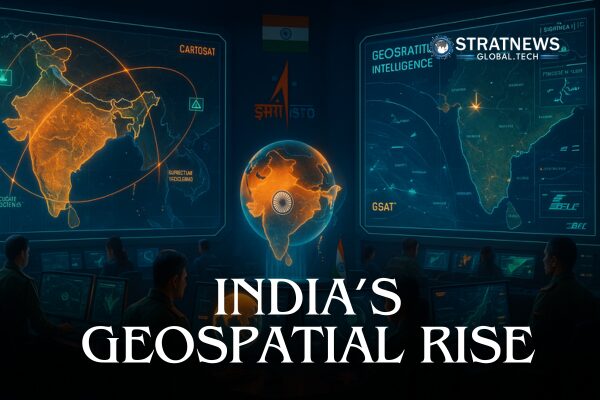Indian National Space Promotion and Authorization Centre (IN-SPACe)’s recent approval of ₹1,200 crore
funding to four Indian private satellite companies—Pixxel, Dhruva Space, SatSure, and Piersight
Space—to develop a 12-satellite Earth Observation constellation marks a significant beginning of a much
awaited, India’s geospatial revolution. While being a much awaited step, the real transformation lies
ahead in what happens next: democratizing data access, building AI-powered analytics platforms, and
creating sector-specific applications that convert raw imagery into actionable intelligence.
The path forward for India will include moving beyond satellite deployment to building data processing
systems, easier access protocols, and specialized training programs. Geospatial intelligence has evolved
from a niche military application to the backbone of modern governance, commerce, and strategic
decision-making. From precision agriculture to border security, the ability to collect, process, and make
decisions on location-based data now determines national competitiveness in the 21st century.
Although the USA and China currently dominate the geospatial sector, India’s emerging initiative is a
crucial development in this rapidly evolving field. Various global incidents in recent times have showcased
the importance and extent of application of Earth Observation data—from mapping conflicts in Ukraine
and Gaza, tracking and predicting natural disasters or assisting mitigation strategies due to impacts of
climate change.
With the geospatial market experiencing significant growth, there are many opportunities opening up for
new players with innovative value propositions. India stepping up in this sector may help reshape the
competitive landscape globally and help address the need for reliable spatial intelligence across diverse
domains. The beauty of this moment lies in recognizing that satellites are the essential foundation, but
they’re also just the beginning of a much larger intelligence ecosystem. The most important
differentiator—and the next exciting frontier—lies in what happens after data collection: processing,
analysis, predictive modeling, and actionable intelligence generation.
With the satellite infrastructure foundation now being strengthened, India is perfectly positioned to tackle
the next challenge: transforming massive amounts of high-resolution imagery and sensor data into
actionable intelligence. This represents an enormous opportunity. Crucially, this transformation must
ensure that datasets become far more democratically accessible than current systems allow, breaking
down the traditional barriers that have kept geospatial intelligence confined to select government
agencies.
The most important prospect lies in addressing the current fragmentation that exists across sectors. The
databases related to agriculture don’t yet seamlessly integrate with that of urban planning.
Defense-related geospatial information remains heavily restricted from civilian applications. Climate
monitoring data and disaster response systems lack proper integration. But rather than seeing this as a
limitation of India’s geospatial ecosystem, it can be viewed as untapped potential.
A plausible solution might be empowering domestic private players to create specialized, processed
datasets for specific purposes like crop monitoring, disaster management, urban planning, border
surveillance and making these datasets accessible to researchers, startups, and government agencies at various levels. This might accelerate India’s geospatial sector growth exponentially while reducing the
time, cost, and effort that government-led initiatives typically require. More importantly, it would ensure that geospatial intelligence becomes a democratized resource rather than remaining concentrated in the
hands of a few players. Hence, a question to be thought about, is: who will ultimately control the
geospatial information that is collected and how democratized will access truly be?
Another frontier to explore is GeoAI—the integration of artificial intelligence with geospatial data that
promises to transform how we understand and interact with our world. The funded satellite companies will
be able to generate extensive amounts of data, making a perfect training ground available for AI-driven
analysis, change detection systems, and automated predictive modeling. Success stories by developing
such sector-specific applications that demonstrate the transformative value of geospatial intelligence will
drive broader adoption that fuel continued growth. This autonomy and control over location data will
become particularly important in times where satellite images are increasingly becoming tools of
geopolitical narratives.
This crowding-in effect can go beyond just satellite manufacturing capabilities. It can encourage
development of integrated data platforms that combine satellite imagery with ground sensors, IoT
devices, and administrative databases to create comprehensive situational awareness systems. The
result would be a truly integrated national geospatial intelligence capability that serves multiple
stakeholders while maintaining strategic autonomy.
Now that the private sector’s capabilities and satellite infrastructure have been reinforced, the next thing
to do is to maximize data access and flow. Streamlining data acquisition and dissemination processes—while maintaining appropriate security considerations—needs immediate attention. There is also a pressing need to develop specialized geospatial skills training programs, rather than treating it as merely a component of broader academic disciplines. The goal isn’t to compromise security but to ensure that pre-existing bureaucratic friction doesn’t limit the effectiveness of these substantial investments.
The question isn’t whether India can succeed, but how well it can continue to capitalize on this foundation.
With the right focus on building comprehensive analytical and application ecosystems—transforming data
into decisions, insights into action, and information into strategic advantage—India can move from being a
capable participant to becoming a major global competitor in this intersection of space and geospatial
technology. This recent investment by IN-SPACe represents not just funding for satellite capabilities, but a
launching pad for much greater achievements. If leveraged correctly, the convergence of policy liberalization through the Indian Space Policy 2023 and National Geospatial Policy of 2022, creates a unique window of opportunity that can accelerate India’s transformation into a geospatial intelligence powerhouse.


